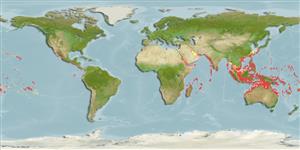Common names from other countries
Environment: milieu / climate zone / depth range / distribution range
Ecologie
marien rifbewoner; diepte 1 - 70 m (Ref. 559). Tropical; 32°N - 26°S
Indo-Pacific: Red Sea and East Africa to the Hawaiian Islands and French Polynesia, north to southern Japan, south to the Great Barrier Reef and New Caledonia.
Grootte / Gewicht / Leeftijd
Maturity: Lm ? range ? - ? cm
Max length : 30.0 cm TL mannelijk / geslacht onbekend; (Ref. 9710)
Dorsale stekels (totaal) : 12; Dorsale zachte stralen (totaal) : 8 - 10; Anale stekels: 3; Anale zachte stralen: 5 - 6. Pectoral fin rays usually 18; back arched; with about 45 vertical scale rows; lachrymal bone with 2 or 3 spines over maxillary, first points forward, followed by 1 or by 2 close-set spines which point down and back; suborbital ridge with 4 or more spinous points, usually more than 8 or 10 points, not in a row and of various sizes; a shallow pit below front corner of eye (Ref. 10482). Colorful inside the pectoral fins, used for display (Ref. 48635).
Relatively an uncommon inhabitant of rubble or weedy coralline-rock bottoms of reef flats and lagoon and seaward reefs (Ref. 9710). Benthic (Ref. 58302). Feeds on fishes (Ref. 89972). Flashes its inner pectoral fins when disturbed (Ref. 9710). Can inflict a painful injury with its venomous dorsal sting. Often partly buried (Ref. 48635). Solitary or in pairs (Ref 90102).
Levenscyclus en paargedrag
Maturities | Voortplanting | Spawnings | Egg(s) | Fecundities | Larven
Randall, J.E and W.N. Eschmeyer, 2001. Revision of the Indo-Pacific scorpionfish genus Scopaenopsis, with descriptions of eight new species. Indo-Pac. Fish. (34):79 p. (Ref. 42181)
Status op de Rode Lijst van het IUCN (Ref. 130435)
CITES (Ref. 128078)
Not Evaluated
Gebruik door de mens
Visserij: commercieel; Aquarium: Commercieel
Tools
Speciale rapporten
Download XML
Internetbronnen
Estimates based on models
Preferred temperature (Ref.
115969): 24.6 - 29, mean 27.7 (based on 1060 cells).
Fylogenetische diversiteitsindex (Ref.
82804): PD
50 = 0.5000 [Uniqueness, from 0.5 = low to 2.0 = high].
Bayesian length-weight: a=0.01259 (0.00606 - 0.02615), b=3.03 (2.86 - 3.20), in cm Total Length, based on LWR estimates for this (Sub)family-body shape (Ref.
93245).
Trofisch niveau (Ref.
69278): 3.8 ±0.58 se; based on food items.
Weerstandsvermogen (Ref.
120179): Gemiddeld, minimale populatieverdubbelingstijd 1,4-4,4 jaar (Preliminary K or Fecundity.).
Fishing Vulnerability (Ref.
59153): Low vulnerability (20 of 100).
